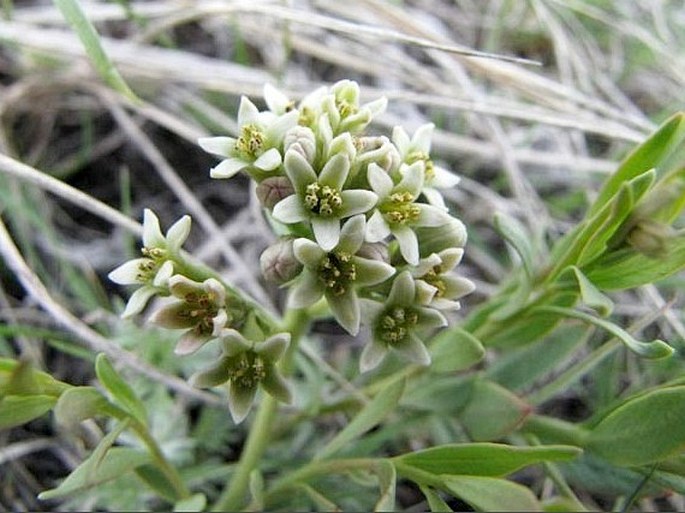Syn.: Comandra cuneifolia Raf., Comandra elliptica Raf., Comandra media Raf., Comandra obovata Raf., Comandra obtusifolia Raf., Comandra umbellulata Raf., Comandra richardsiana Fernald, Hamiltonia umbellata Spreng., Thesium corymbosulum Michx., Thesium umbellatum L.
Family: Santalaceae R. Br.

Distribution: North American species found in all Canada and US with exception of Florida, as 3 subspecies; nominate in mostly east, C. u. subsp. pallida in western parts and C. u. subsp. californica in British Columbia and western coastal states reaching California.
Ecology: Dry open areas, prairie grasslands and rocky slopes, plains to foothills. Blooms in June and July.
Description: Perennial herb, semi-parasitic, 10–40 cm tall, from creeping, white rhizomes, roots attach themselves to other plants with small sucker-like organs and obtain water and nutrients from host plant. Stems erect; leaves alternate, numerous, linear to narrowly lanceolate, 1–2.5 cm long, short-petioled or sessile, somewhat fleshy, hairless, pale green with bluish cast; inflorescence a panicle of numerous 3–5-flowered terminal cymes; flowers greenish white to pinkish, 4–6 mm, sepals 5, petals absent, stamens 5, pistil 1. Fruit is a berry-like drupe, green to purplish, 4–8 mm, sepals persistent, forming a crown.
Use: Edible in small quantities; too much can cause nausea.
An attractive rockery plant but must be grown close to other plants which it can parasitize.
Note: This plant is a host of fungus Cronartium comandrae called Comandra Blister Rust which appears as bright yellow spots covering most of the plant, making it look yellow and the rosettes of leaves look like tiny flowers. Following year the spores are produced and the rust attacks pines, trees of genus Pinus, as the secondary host and in this stage it is quite destructive.





These images were taken in Canada, Alberta, Calgary, Confluence Park (June 2014), and Alberta, Sandy Beach (April 13, 2015).


